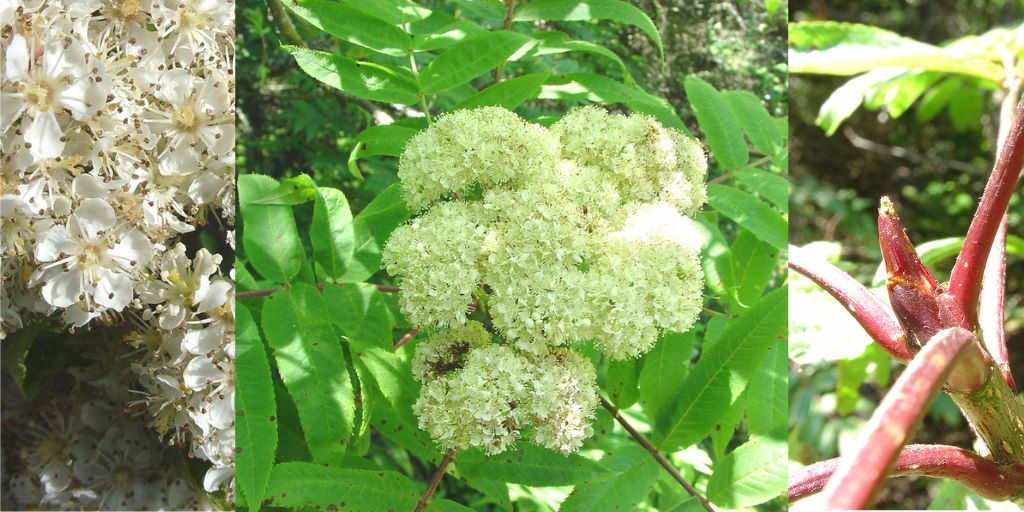Nature Notes: A Maine Naturalist Afield

Transcript
Having spent the majority of my life traveling about the Maine Woods, often with my head craned skyward tracking the movements of a bird through the canopy, I’ve become quite familiar with our state’s diverse array of tree species, from the lofty White Pines to sprawling Bear Oaks. Every now and again, however, I’ll cross paths with something unfamiliar, a species I’ve either never encountered or, more likely, completely overlooked. Such was the case when I first became acquainted with the mountain-ash, a species of tree I know count among my favorites.
I remember the day well. I was bushwhacking from a logging trail upwards along a mountain slope in the wee hours, en route to conduct an alpine bird survey as a technician for the Maine Bird Atlas. After pushing my way through thickets of regenerating spruce-fir, I stepped out into a small clearing. Poking out among flattened canes of raspberries and currants were a scattering of gnarled, upright woody stems. If not for their few pieces of dew-misted greenery glinting in my headlamp, I might not have recognized that they were alive at all. I’d also likely have overlooked the adjacent piles of moose droppings too. I did pause, however, and took some photographs, surmising that, whatever this plant was, it was clearly a preferred bit of forage for local moose.
Returning to my campsite that same day, I thumbed through a copy of “Forest Trees of Maine”, comparing written descriptions against my images. I determined that the stunted, moose-browsed twigs I’d seen were rather underwhelming specimens of American Mountain-Ash (Sorbus americanus), our continent’s equivalent of the Old World’s Rowantree (or Sorbus aucuparia).
Across the Atlantic, European Rowan has a long and storied history of usage and has developed a rich regional folklore and myriad of local names including the highly appropriate “bird-berry tree”. The use of mountain-ash fruits by birds is common across species around the globe. Indeed, the clusters of scarlet fruits are reason enough to pay mind to our own New World rowans. Thrushes, waxwings, grouse, jays, as well as many small mammals partake of the generous bounties provided by these trees. They are particularly beneficial come winter as food sources dwindle. These fruits are particularly favored by Bohemian Waxwings who stage irruptions from their breeding grounds in the northwest when local fruit crops are depleted.
Trees belonging to the genus Sorbus are not truly ash trees – that is, they are not closely related to the Black Ash, White Ash, and Green Ash trees (each belonging to the genus Fraxinus) found in our state’s rich-soiled bottomlands. While both ashes and mountain-ashes bear superficially similar compound leaves, the latter are members of the Rose family and therefore more closely related to apples than ashes.
Over the course of my survey efforts, I would encounter both moose-stunted mountain-ash trees as well as more developed specimens, usually perched on the edges of rocky slopes too steep to permit browsing. When unhindered, this tree takes on a limber and sinuous form, complete with many smooth-barked branches and crowned in dark greenery. Each speartip-shaped leaflet is edged with a series of fine, saw-like teeth. In summer, clusters of snow white flowers are held sunward like tiny parasols attracting the attention of many bees, flies, and other insects. I’d often choose resting places beneath these trees from which I could watch as they swayed in the rising alpine breeze. Here, the filtered sunlight could scatter across the moist carpet of sphagnum, bunchberry, and clintonia.
Having crossed paths with enough mountain-ashes, I began noticing that some individuals consistently bore stoater, more ovate leaflets. Revisiting my guide, I found that these individuals were another mountain-ash species altogether: Sorbus decora, or the Showy Mountain Ash. In form and habit, this tree is much like its “American” kin. It, too, is capable of flourishing on rocky slopes or trailside openings. Of the two species native to New England, this Showy species is a more northerly distributed tree with range extended further northward on the Canadian Shield. It is one of the few hardy tree species found within the few forested valleys of southwestern Greenland. In the years since, I have encountered many mountain-ash trees of both species while traveling and working within the Western Mountains, the North Maine Woods, and along the Downeast coast. When our first child was on the way, I planted a few saplings of each species that I’d collected beside our home. Should these trees thrive, perhaps we can look forward to sitting beside the woodstove on some far off winter day and watching for waxwings among red rowan fruits just outside our window.
Related Episodes
-

12/8/24: Seasonal Shift
The transition from summer to autumn ushers in more than just magnificent foliage. Join Logan on a stroll through…
-

1/19/25: Hollies of Maine
Hollies have long been associated with winter celebrations, both “across the pond” and here at home. Here we introduce…


